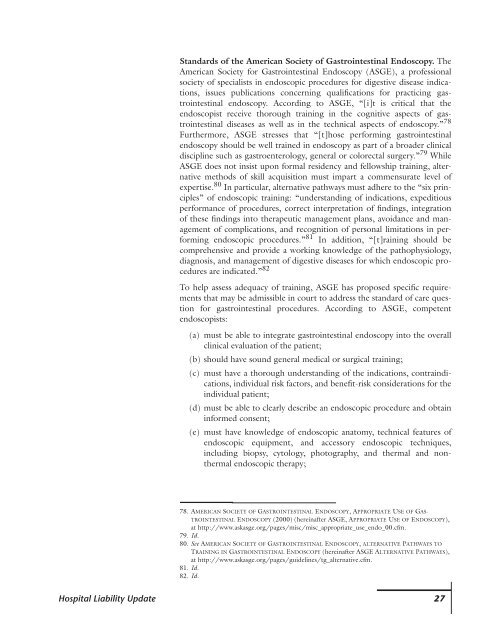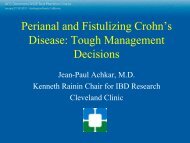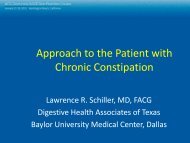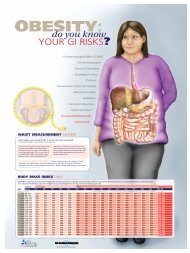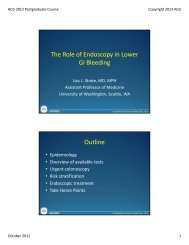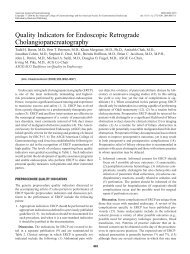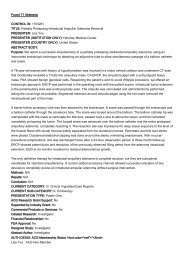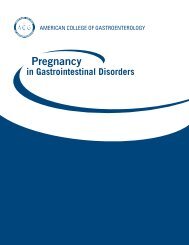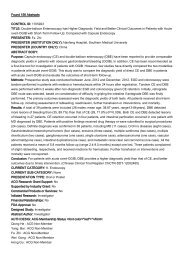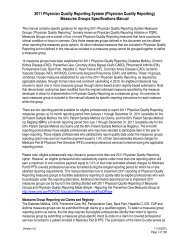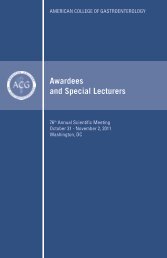Ensuring Competence in Endoscopy - American College of ...
Ensuring Competence in Endoscopy - American College of ...
Ensuring Competence in Endoscopy - American College of ...
Create successful ePaper yourself
Turn your PDF publications into a flip-book with our unique Google optimized e-Paper software.
Standards <strong>of</strong> the <strong>American</strong> Society <strong>of</strong> Gastro<strong>in</strong>test<strong>in</strong>al <strong>Endoscopy</strong>. The<br />
<strong>American</strong> Society for Gastro<strong>in</strong>test<strong>in</strong>al <strong>Endoscopy</strong> (ASGE), a pr<strong>of</strong>essional<br />
society <strong>of</strong> specialists <strong>in</strong> endoscopic procedures for digestive disease <strong>in</strong>dications,<br />
issues publications concern<strong>in</strong>g qualifications for practic<strong>in</strong>g gastro<strong>in</strong>test<strong>in</strong>al<br />
endoscopy. Accord<strong>in</strong>g to ASGE, “[i]t is critical that the<br />
endoscopist receive thorough tra<strong>in</strong><strong>in</strong>g <strong>in</strong> the cognitive aspects <strong>of</strong> gastro<strong>in</strong>test<strong>in</strong>al<br />
diseases as well as <strong>in</strong> the technical aspects <strong>of</strong> endoscopy.” 78<br />
Furthermore, ASGE stresses that “[t]hose perform<strong>in</strong>g gastro<strong>in</strong>test<strong>in</strong>al<br />
endoscopy should be well tra<strong>in</strong>ed <strong>in</strong> endoscopy as part <strong>of</strong> a broader cl<strong>in</strong>ical<br />
discipl<strong>in</strong>e such as gastroenterology, general or colorectal surgery.” 79 While<br />
ASGE does not <strong>in</strong>sist upon formal residency and fellowship tra<strong>in</strong><strong>in</strong>g, alternative<br />
methods <strong>of</strong> skill acquisition must impart a commensurate level <strong>of</strong><br />
expertise. 80 In particular, alternative pathways must adhere to the “six pr<strong>in</strong>ciples”<br />
<strong>of</strong> endoscopic tra<strong>in</strong><strong>in</strong>g: “understand<strong>in</strong>g <strong>of</strong> <strong>in</strong>dications, expeditious<br />
performance <strong>of</strong> procedures, correct <strong>in</strong>terpretation <strong>of</strong> f<strong>in</strong>d<strong>in</strong>gs, <strong>in</strong>tegration<br />
<strong>of</strong> these f<strong>in</strong>d<strong>in</strong>gs <strong>in</strong>to therapeutic management plans, avoidance and management<br />
<strong>of</strong> complications, and recognition <strong>of</strong> personal limitations <strong>in</strong> perform<strong>in</strong>g<br />
endoscopic procedures.” 81 In addition, “[t]ra<strong>in</strong><strong>in</strong>g should be<br />
comprehensive and provide a work<strong>in</strong>g knowledge <strong>of</strong> the pathophysiology,<br />
diagnosis, and management <strong>of</strong> digestive diseases for which endoscopic procedures<br />
are <strong>in</strong>dicated.” 82<br />
To help assess adequacy <strong>of</strong> tra<strong>in</strong><strong>in</strong>g, ASGE has proposed specific requirements<br />
that may be admissible <strong>in</strong> court to address the standard <strong>of</strong> care question<br />
for gastro<strong>in</strong>test<strong>in</strong>al procedures. Accord<strong>in</strong>g to ASGE, competent<br />
endoscopists:<br />
(a) must be able to <strong>in</strong>tegrate gastro<strong>in</strong>test<strong>in</strong>al endoscopy <strong>in</strong>to the overall<br />
cl<strong>in</strong>ical evaluation <strong>of</strong> the patient;<br />
(b) should have sound general medical or surgical tra<strong>in</strong><strong>in</strong>g;<br />
(c) must have a thorough understand<strong>in</strong>g <strong>of</strong> the <strong>in</strong>dications, contra<strong>in</strong>dications,<br />
<strong>in</strong>dividual risk factors, and benefit-risk considerations for the<br />
<strong>in</strong>dividual patient;<br />
(d) must be able to clearly describe an endoscopic procedure and obta<strong>in</strong><br />
<strong>in</strong>formed consent;<br />
(e) must have knowledge <strong>of</strong> endoscopic anatomy, technical features <strong>of</strong><br />
endoscopic equipment, and accessory endoscopic techniques,<br />
<strong>in</strong>clud<strong>in</strong>g biopsy, cytology, photography, and thermal and nonthermal<br />
endoscopic therapy;<br />
78. AMERICAN SOCIETY OF GASTROINTESTINAL ENDOSCOPY, APPROPRIATE USE OF GAS-<br />
TROINTESTINAL ENDOSCOPY (2000) (here<strong>in</strong>after ASGE, APPROPRIATE USE OF ENDOSCOPY),<br />
at http://www.askasge.org/pages/misc/misc_appropriate_use_endo_00.cfm.<br />
79. Id.<br />
80. See AMERICAN SOCIETY OF GASTROINTESTINAL ENDOSCOPY, ALTERNATIVE PATHWAYS TO<br />
TRAINING IN GASTROINTESTINAL ENDOSCOPY (here<strong>in</strong>after ASGE ALTERNATIVE PATHWAYS),<br />
at http://www.askasge.org/pages/guidel<strong>in</strong>es/tg_alternative.cfm.<br />
81. Id.<br />
82. Id.<br />
Hospital Liability Update 27


